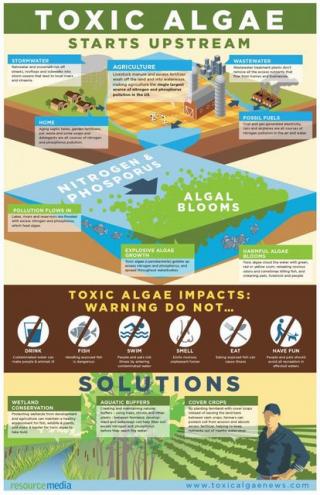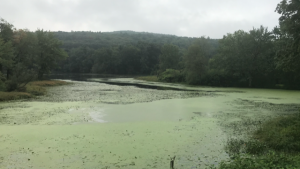Blue Green Algae Blooms

Blue-green algae can form harmful blooms in lakes, ponds, and rivers that make the water murky, and can sometimes make the water look like pea soup or paint.
Blue-green algae blooms can produce toxins that can make pets and people sick. Toxins may be present within the algae cells or in the water.
For humans, the primary concern is ingestion of water containing blue-green algae while swimming. Of secondary concern is direct skin contact with the blue-green algae and inhalation of water droplets containing blue-green algae or toxins.
For pets, the primary concern is the ingestion of water containing blue-green algae or scum that has washed ashore or gotten onto their skin or fur.
Contact can cause skin and eye irritation, and inhalation can cause respiratory irritation and exacerbate pre-existing respiratory conditions. Toxins are not absorbed through the skin. Ingestion of blue-green algae can cause acute gastrointestinal symptoms, such as vomiting and diarrhea. If the blue-green algae are producing toxin(s), the health effects can be more serious, especially for small pets due to their smaller body weights. Ingestion of the toxins can cause acute gastrointestinal distress and, depending on the specific toxin, can affect the functioning of the liver, kidneys, and/or neurological systems and in
severe cases can result in death.
Pet Safety
Call your vet immediately if your pet has been around an algae bloom and shows symptoms such as vomiting, staggering, drooling, or convulsions. These symptoms present themselves fairly quickly after exposure. Animals of most concern are dogs. They have been known to eat the scum that washes ashore and/or lick scum out of their fur. In Massachusetts and in many other states, canine fatalities have been documented due to the ingestion of harmful algae. Learn additional details on additional safety precautions by viewing the Protecting Pets from Algae Blooms (PDF).
When are water advisories lifted?
Algae blooms may last for weeks in the summer, or may disappear quite quickly. Town staff will regularly observe Lake Warner for the presence of a visible algae bloom to determine if a recreational water use advisory shall continue to be issued. MDPH recommends that the recreational water advisory not be lifted until 2 consecutive weekly samples show algal cell counts below the safe limit of 70,000 cells/milliliter of water, or until two weeks after the bloom has faded.
The Hadley Board of Health advises:
IF YOU OBSERVE AN ALGAE BLOOM
- Do not swim
- People and pets should avoid contact in areas of algae concentration, even on shore
- Do not allow your pet to swim in or drink the water
- Do not swallow water and be sure to rinse off after contact
AUGUST 18th, 2020 -- LAKE WARNER - N. HADLEY 
Lake Warner is experiencing a bloom of cyanobacteria (blue-green algae) which was first observed in early August. The bloom may be observed as a floating mixed blue/green/yellow scum along some areas of the shoreline; in other areas of the lake the water has a blueish tint from the algae.
Users of the lake should be aware that a bloom may be present, and avoid contact with any visible floating bloom or scum. Blue green algae blooms may produce toxins that can make pets and people sick.
CONTINUED INFORMATION CAN BE FOUND THOUGH:
Massachusetts Department of Public Health
www.mass.gov/dph/algaeMassachusetts Department of Environmental Protection:
https://www.mass.gov/guides/cyanobacterial-harmful-algal-blooms-cyanohabs-waterU.S. Centers for Disease Control and Prevention:
https://www.cdc.gov/habs/index.htmlU.S. Environmental Protection Agency:
www.epa.gov/cyanohabs

